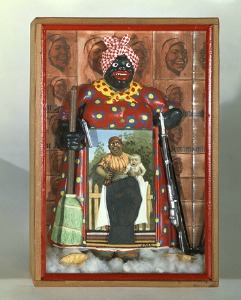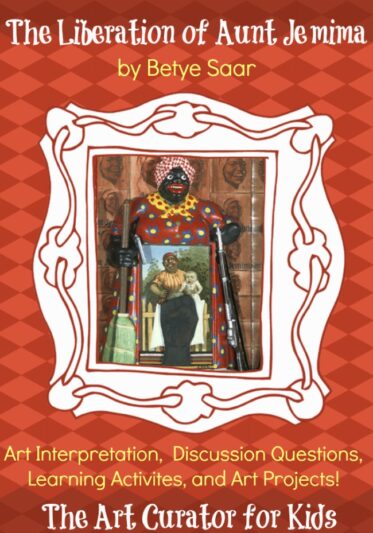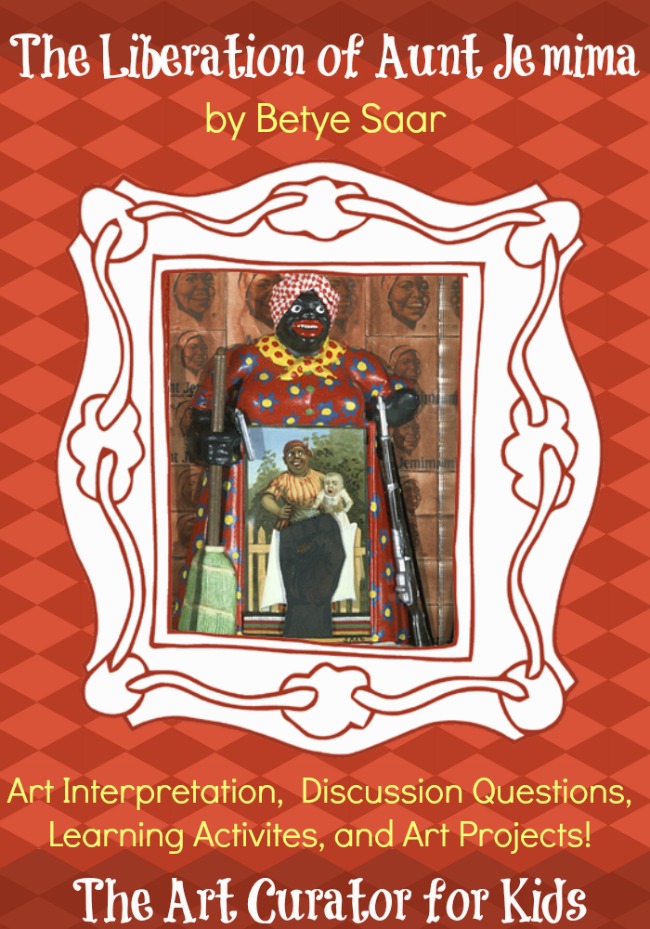Today’s artwork is The Liberation of Aunt Jemima by Betye Saar.
Exploring Tough Topics through Art
This artist uses stereotypical and potentially-offensive material to make social commentary. I feel it is important not to shy away from these sorts of topics with kids. We can’t sugar coat everything and pretend these things don’t exist if we want things to change in our world. We need to have these hard conversations and get kids thinking about the world and how images play a part in shaping who we are and how we think. Art is an excellent way to teach kids about the world, about acceptance, and about empathy.
Betye Saar’s The Liberation of Aunt Jemima

This artwork is an assemblage which is a three-dimensional sculpture made from found objects and/or mixed media. It’s essentially like a 3d version of a collage.
In the artwork, Saar included a knick-knack she found of Aunt Jemina. It was Aunt Jemima with a broom in one hand and a pencil in the other with a notepad on her stomach. Instead of the pencil, she placed a gun, and in the other hand, she had Aunt Jemima hold a hand grenade. In the spot for the paper, she placed a postcard of a stereotypical “mammy” holding a biracial baby. The mammy’s skirt is made up of a black fist, a black power symbol. She put this assemblage into a box and plastered the background with Aunt Jemima product labels.
Art Discussion Questions
Okay, now that you have seen the artwork with the description, think about the artwork using these questions as a guide. Or, use these questions to lead a discussion about the artwork with your students.
- What was your first reaction to seeing this image?
- What do these images remind you of?
- Describe the women in this image. What is wrong about how they are portrayed?
- What is the artist trying to say by putting these objects and images together? What is her message?
- Saar called this her first protest piece. What is she protesting?
- Why do you think the artist included the gun and hand grenade? Do you think they symbolize violence or something else?
Interpretation of Betye Saar’s The Liberation of Aunt Jemima
Saar’s goal in using these controversial and racist images was to reclaim them and turn them into positive symbols of empowerment. Instead of me telling you about the artwork, let’s hear it from the artist herself!
Watch this video of Betye Saar discussing The Liberation of Aunt Jemima:
Isn’t it so great we have the opportunity to hear from the artist?
Related Art Learning Activities
Use these activities to further explore this artwork with your students.
Stereotypes Art Project:
Students can make a mixed-media collage or assemblage that combats stereotypes of today. It’s easy to see the stereotypes and inappropriateness of the images of the past, but today these things are a little more subtle since we are immersed in images day in and day out. Have students look through magazines and contemporary media searching for how we stereotype people today through images (things to look for: weight, sexuality, race, gender, etc.). Then, have students take those images and change and reclaim them as Saar did with Aunt Jemima.
Research and Writing Activity:
Have students study stereotypical images of African Americans from the late 1800s and early 1900s and write a paper about them. They also could compare the images from the past with how we depict people today (see art project above).
Study More Artists:
Have students study other artists who appropriated these same stereotypes into their art like Michael Ray Charles and Kara Walker. Students can look at them together and compare and contrast how the images were used to make a statement. Note: I would not study Kara Walker with kids younger than high school. There are some disturbing images in her work that the younger kids may not be ready to look at.
This post was originally published on February 15, 2015.



